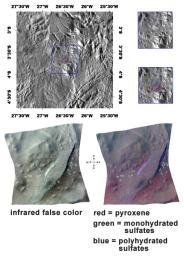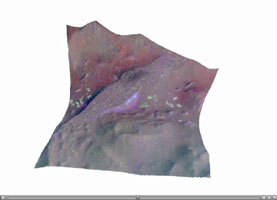
|
The Minerals of Aureum Chaos
- Click the image above for a larger view
- Full-Res JPEG (1592 x 2208) (449.5 kB)
- Full-Res TIFF (1592 x 2208) (10.6 MB)
Caption:

Click on image for animation of
3-dimensional model with 5x vertical exaggeration
This image of chaotic terrain in the Aureum Chaos region of Mars was taken by the Compact Reconnaissance Imaging Spectrometer for Mars (CRISM) at 0858UTC (3:58 a.m. EST) on January 24, 2008, near 3.66 degrees south latitude, 26.5 degrees west longitude. The image was taken in 544 colors covering 0.36-3.92 micrometers, and shows features as small as 18 meters (60 feet) across. The image is about 10 kilometers (6.2 miles) wide at its narrowest point.
Aureum Chaos is a 368 kilometer (229 mile) wide area of chaotic terrain in the eastern part of Valles Marineris. The chaotic terrain is thought to have formed by collapse of the surrounding Margaritifer Terra highland region. Aureum Chaos contains heavily eroded, randomly oriented mesas, plateaus, and knobs—many revealing distinct layered deposits along their slopes. These deposits may be formed from remnants of the collapsed highlands, sand carried by Martian winds, dust or volcanic ash that settled out of the atmosphere, or sediments laid down on the floor of an ancient lake.
The top panel in the montage above shows the location of the CRISM image on a mosaic taken by the Mars Odyssey spacecraft's Thermal Emission Imaging System (THEMIS). The CRISM data cover a narrow plateau near the edge of the chaotic terrain, that stretches across from the southwest to the northeast.
The lower left image, an infrared false color image, reveals the plateau and several eroded knobs of varying sizes. The plateau's layer-cake structure is similar to that of other layered outcrops in Valles Marineris.
The lower right image reveals the strengths of mineral spectral features overlain on a black-and-white version of the infrared image. Areas shaded in red hold more of the mineral pyroxene, a primary component of basaltic rocks that are prevalent in the highlands. Spots of green indicate monohydrated sulfate minerals (sulfates with one water molecule incorporated into each molecule of the mineral), while blue indicates polyhydrated sulfate minerals (sulfates with multiple waters per mineral molecule).
Although the plateau's dark cap rock is somewhat mineralogically non-descript, the bright, white swath of underlying material cascading down the plateau's flanks appears to hold polyhydrated sulfates. Dark eolian or wind deposited sediments in the south-central part of the plateau are also rich in polyhydrated sulfates.
Surrounding the plateau are small greenish spots of monoyhydrated sulfates. These are erosional remnants of an even lower part of the layered deposits that is compositionally distinct from the main part of the plateau.
The deepest layer visible is preexisting "basement" rock that forms the floor of Aureum Chaos around the plateau. It is comprised of basaltic rock exposed by collapse of the crust and the debris derived from that collapse.
The animation (see above) of a 3-dimensional topographic model illustrates the relationship of these materials. It was made using the lower right CRISM image, draped over MOLA topography with 5X vertical exaggeration.
Background Info:
CRISM is one of six science instruments on NASA's Mars Reconnaissance Orbiter. Led by The Johns Hopkins University Applied Physics Laboratory, Laurel, Md., the CRISM team includes expertise from universities, government agencies and small businesses in the United States and abroad. NASA's Jet Propulsion Laboratory, a division of the California Institute of Technology in Pasadena, manages the Mars Reconnaissance Orbiter and the Mars Science Laboratory for NASA's Science Mission Directorate, Washington. Lockheed Martin Space Systems, Denver, built the orbiter.
Cataloging Keywords:
| Name | Value | Additional Values |
|---|---|---|
| Target | Mars | |
| System | ||
| Target Type | Planet | |
| Mission | Mars Reconnaissance Orbiter (MRO) | 2001 Mars Odyssey, Mariner, Mars Science Laboratory (MSL) |
| Instrument Host | Mars Reconnaissance Orbiter | Curiosity Rover, Mars Odyssey |
| Host Type | Orbiter | Flyby Spacecraft, Rover |
| Instrument | Compact Reconnaissance Imaging Spectrometer for Mars (CRISM) | |
| Detector | ||
| Extra Keywords | Atmosphere, Color, Dust, Infrared, Thermal, Volcano, Water | |
| Acquisition Date | ||
| Release Date | 2008-05-09 | |
| Date in Caption | 2008-01-24 | |
| Image Credit | NASA/JPL/JHUAPL/ASU | |
| Source | photojournal.jpl.nasa.gov/catalog/PIA10943 | |
| Identifier | PIA10943 | |
